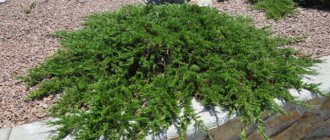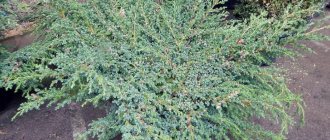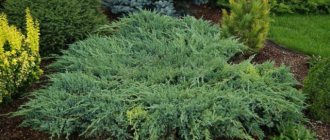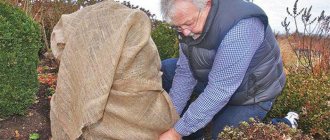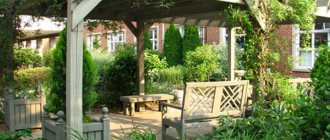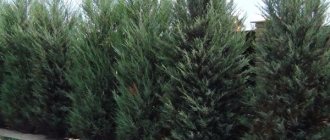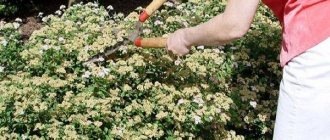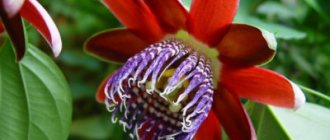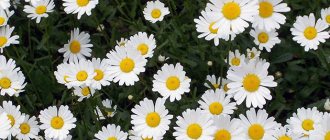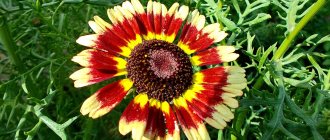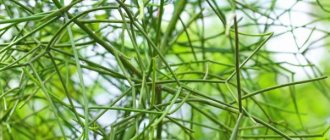General description of Cossack juniper
Cossack juniper Juniperus sabina is a perennial conifer from the genus of the same name. It is a beautiful creeping plant with soft green needles of two types:
- tough. Pointed, erect needles 4–6 mm long;
- soft. Interesting bluish-green color.
The trunks are curved and covered with red-brown bark. The layers are gradually separated and replaced by new ones. The shoots and needles give off a pleasant pine smell, and if you rub them in your hands, they give off a sharp, strong aroma.
In nature, the plant is found in the temperate climate zone of Europe, in the central part of Russia (Black Earth Region, Kuban, North Caucasus), as well as in the steppes of the Urals, Siberia and Kazakhstan. Prefers fertile soils, minimal moisture and brightly lit places.
Attention! The composition of plant tissues contains sabinol essential oil with toxic properties.
Therefore, it is better to prevent children and pets from coming into contact with the plant.
Cossack juniper is distinguished by its pleasant greenery and spreading branches that spread densely along the ground
Winter hardiness of Cossack juniper
The plant is characterized by high winter hardiness (USDA zone 3). It withstands even severe frosts down to –40 °C. Therefore, this plant can be grown almost everywhere in Russia:
- Central part;
- Northwest;
- Ural;
- Western and Eastern Siberia.
The coastal climate is less suitable for juniper, since conifer prefers periodic droughts. However, you can try to grow it in the regions of the Far East. In this case, the watering rate should be reduced by 1.5–2 times.
Growth rate and size of Cossack juniper
Cossack juniper is a creeping shrub, but its height is large - about 1–1.5 m. These are not the maximum dimensions for the crop - even at home it can reach 2 m, and sometimes there are especially large specimens up to 4 m. The diameter of the plant reaches 2.5 m (by 10 years) and 5–7 m (by 20 years). The annual growth is about 20 cm (width) and 10 cm (height).
Growth rates mainly depend on the correct choice of location and cultivation technology:
- Cossack juniper does not tolerate stagnant moisture - therefore lowlands should be avoided;
- grows well in lighted areas, without any shade;
- the soil should be fertile and loose - black soil, loam;
- Regular loosening of the soil is necessary to provide the roots with oxygen and nutrients.
Annual growth (in meters) of a crop using the example of the Mas variety.
Important! The average lifespan of Cossack juniper is 500 years.
Features of flowering of Cossack juniper
Cossack juniper is a dioecious plant (it has both male and female flowers). The berries are cone-shaped, small in size (up to 7 mm long), colored brown and black. Seeds ripen in 2 stages - in the fall and next spring.
Reproduction
In nature, Cossack juniper spreads through seeds and layering. At home, you can additionally carry out cuttings or grafting. Seed material for propagation is rarely used, since the method takes the longest and does not preserve the varietal characteristics of the plant. If necessary, the seeds must first be subjected to stratification. Grafting is used for elite hybrids, but is also not always justified, since there are simpler methods of reproduction.
It is more often recommended to plant independently formed layerings. When the shoots of Cossack juniper touch the ground, they sprout roots. When they reach normal size, it is enough to simply plant the bush. To root a twig of a variety whose shoots do not spread along the ground, it is enough to bend it down, attach it with wire, periodically hill it up and water the place in contact with the soil.
Cuttings are carried out in the spring or at the end of August - beginning of September. The shoot should be torn off with the heel, and the cut site should be treated with a growth stimulator. Root in a moistened, loose nutrient substrate, deepening it to 3-5 cm. A full-fledged root system will be formed in 2.5-3 months, after which it is transplanted into open ground. It is permissible to grow juniper cuttings in containers for the first 2-3 years.
Varieties of Cossack juniper
Cossack juniper is a species that includes several varieties (pictured). Plant characteristics will help you choose a seedling for any site.
Knap Hill
Knap Hill is a famous variety of Cossack juniper, considered one of the most beautiful. Reaches 75–100 cm in height by 10 years (maximum height up to 150 cm).
The crown diameter of the Knap Hill juniper reaches only 160 cm, so the bush takes on a beautiful symmetrical shape
Important! This variety has reduced winter hardiness (down to –34 °C).
Therefore, in the first years of planting, it is necessary to cover it with spruce branches, leaf litter or other breathable materials.
Tamariscifolia
Tamariscifolia is an ornamental variety with a relatively large crown (diameter up to 2.5 m). The needles are bluish-green in color, the needle-shaped layer predominates. The needles are slightly curved, bluntly pointed. Not recommended for dense planting - neighboring branches may dry out.
This variety of Cossack juniper looks good as a tapeworm
Mas
Mas (Juniperus Sabina Mas) is a miniature variety of Cossack juniper, up to 30 cm high, with a crown width of up to 40 cm. It is often grown in flower pots. It is possible to plant on the site (on hills, away from roofs from which snow falls). Suitable for rock gardens and edging paths.
The Mas variety can be grown in flower pots
Buffalo
Buffalo is a large juniper that grows up to 1.5 m in height and up to 5 m in width. Basically, the shrub takes on a creeping form, although sometimes the stems are erect. The needles are scaly, of a beautiful emerald hue.
The Buffalo variety has a fast growth rate
Arcadia
Cossack juniper Arcadia is characterized by maximum spreading. With a height of only 40–50 cm, the crown grows to 2–4 m in diameter.
Arcadia shrub attracts attention with soft green needles with bluish tints
Femina
Femina is a variety of Cossack juniper with a wide crown (on average 2 m, sometimes up to 4–5 m) and small height (no more than 1.5 m). The needles are dark green in color, the needles are frequent and fit tightly to the branches.
The Femina variety has a classic grassy green color.
Glauka
Cossack juniper Glauca grows up to 1 m, its crown spreads up to 4–5 m. It is decorative thanks to its blue-green, bluish needles, which acquire a bronze tint closer to winter.
Cossack juniper Glauka is planted according to a 70x70 cm pattern
Attention! Over the course of three years, the bush grows slowly. After this, the growth rate increases significantly.
Cupressifolia
Cupressifolia is a dwarf variety. The bush grows up to 60 cm, while the crown is quite compact: up to 1.5 m in diameter. The supporting skeletal branches produce many shoots that grow at different speeds (up to 15 cm per year). As a result, the crown turns out to be dense and asymmetrical, so it needs to be periodically shaped.
Cupressifolia is distinguished by beautiful, lush branches with light green needles
Rockery Jam
Cossack juniper Rockery Gem is a low-growing variety. Even at the age of ten, the shoots do not grow higher than 20 cm, while the size of the crown is 10 times larger - up to 200 cm. Over time, adult plants reach 50 cm, but then their height growth stops.
Rockery Jam is one of the few varieties of Cossack juniper that prefers moist soils
Hixie
Hicksii is a plant with a wide, spreading crown. At the age of ten, the diameter of the crown is 200 cm. The height is also large - from 100 to 150 cm. The needles are bluish in the warm season, and towards the end of autumn they become dark green or purple.
The Cossack juniper variety Hixi is distinguished by large and soft needles
Broadmoor
Another interesting variety of Cossack juniper is Broadmoor. A low bush up to 60 cm with a wide crown up to 250 cm. The needles are attractive, bright green, sometimes with grayish tints.
Broadmoor exudes a pleasant spruce aroma
Variegata
Variegata is a dwarf variety. Height up to 20 cm, crown up to 200 cm. Suitable for ground cover plantings. The needles are gray-green with pale yellow inclusions.
Variegata is decorative due to its small size and unique color of needles
Blue Danube
Blue Danube is a low shrub (up to 1 m) with a relatively compact crown (diameter up to 1.5 - 2 m). The needles are scaly, dense, and have bluish tints. The plant loves both illuminated areas and partial shade. 15
Blue Danube tolerates drought well, but excessive watering is unacceptable.
False Cossack
Juniperus pseudosabina is a species, not a cultivar, of juniper. Moreover, it is not directly related to the Cossack language, but is similar to it only in appearance. False Cossack juniper is a creeping shrub, but it reaches a height of 2 m.
The needles are scaly, very small (up to 2–3 mm in length), rich green in color. The plant is monoecious, so if there is only 1 bush on the plot, it will not bear fruit. The cone berries are black, small, about 1 cm long.
The false Cossack species often takes the form of a low tree rather than a creeping shrub
Caring for Cossack juniper
Growing conditions on site
Planting and caring for Cossack juniper is carried out in accordance with the agricultural practices of coniferous plants. Juniper requires watering only in dry times, and even then infrequently - only 2-3 times during the summer. Water consumption is from 10 to 30 liters per plant. In hot weather and drought, it is advisable to spray the bush once a week in the evening. The soil around young plants is loosened shallowly after watering, while removing weeds.
Nitroammofoska applied in April or May at the rate of 30-40 g per m², or a solution of 20 g of Kemira-lux in 10 liters of water, is suitable as a fertilizer for juniper. In the winter, heat-loving plant varieties are mulched with peat, leaves or other organic matter, but in the spring this mulch must be removed to avoid rotting of the root collar.
Transfer
It is better to replant Cossack juniper at a young age, since it is difficult for an adult plant to take root in a new place due to the fact that when digging it up, the overgrown root system is severely damaged. Cossack juniper is replanted in early spring, as soon as the snow melts, but the bush must be prepared for replanting at least six months in advance: the plant is dug around the perimeter of the crown projection, vertically cutting off too long roots. They do this so that before replanting the bush has time to form a compact root system in the area limited by you and endures the replanting less painfully.
The hole in the new location is prepared in the same order as for the initial planting, taking into account the size of the root system of the bush. Only healthy plants without signs of any diseases are replanted. Before digging up the juniper, tie a ribbon to one of the north-facing branches, because the north-south orientation must be maintained when replanting. Before transplanting, the seedling is dug as deep as possible to preserve as many roots as possible. The dug up bush is transferred to a large piece of dense polyethylene and its root system is treated with a root formation stimulator, after which the plant is dragged to the planting site, placed in a pit and the voids are filled with a previously prepared soil mixture. The surface around the bush is carefully trampled, then a border is made around the perimeter of the planting hole and two buckets of water are poured under the bush. When the water is absorbed, the tree trunk circle is filled with humus from under the juniper or forest litter, and three strong pegs are driven deeply at an equal distance from each other along the edges of the hole at an angle from the seedling and a bush is tied to them.
The crown of the Cossack juniper is treated with fungicide solutions until the plant takes root. Make a groove around the perimeter of the tree trunk circle and pour a bucket of water into it twice a week: the water should not get on either the needles or the trunk of the plant. Epin's solution is used as a fertilizer on the leaves; in hot weather, the juniper is covered from the scorching sun with burlap, and in the evenings the crown is sprayed with water.
Diseases and pests
Juniper, like no other plant, is susceptible to rust, so do not plant it close to apple trees, pears and other representatives of the Rosaceae family. A sign of rust is the formation on the shoots of the plant of small, half a centimeter in size, red-colored formations, reminiscent of tinder fungi. If you notice such growths, the shoot should be removed immediately by cutting it a few centimeters below the affected area. After this, you need to treat the plant with a fungicide solution. For preventive purposes, juniper is treated with Topaz or another fungicide of similar action from mid-July to mid-September every two weeks.
Juniper is also affected by the fungal disease fusarium, or tracheomycosis wilt, which causes rotting of the root system. The mycelium penetrates the roots of the plant and fills them, as a result of which the roots turn brown, the supply of nutrients to the crown stops, the needles turn yellow, starting from the lower shoots, turn red and fall off, and the bush itself dries out. Young plants suffer most from tracheomycosis. It is difficult to identify this disease at an early stage because it occurs in a latent form, and when the lesion is detected, it is usually too late to take action. At the first symptoms of wilting, you need to etch the soil in which the juniper grows with a solution of Fitosporin-M, Alirin-B or Gamaira. As a preventive measure and to eradicate infection, plants are treated and the soil is spilled with a solution of Fundazol. Plants that cannot be saved are uprooted and burned, and the soil in which they grew is sprayed with fungicide.
Brown schutte develops on Cossack juniper in the winter, and in the spring you suddenly find yellow and brown needles on the branches freed from snow, entangled in gray cobwebby mycelium, which over time becomes black-brown and sticky. Thin branches die, but the dirty brown needles do not fall off for a long time. It is necessary to remove the affected areas from the plant as quickly as possible and treat the bush with one percent Bordeaux mixture, HOM or Abiga-Peak preparations. Most likely, the problem cannot be solved with one treatment: you will have to re-spray in a week or two, and maybe more than one.
Drying of juniper branches is caused by several types of fungi. The disease manifests itself by drying out of the bark and the formation of brown and black fruiting bodies on it, then the Cossack juniper turns yellow and dries out. Thickened plantings contribute to the development of the disease. It is necessary to remove diseased branches, and treat cuts and wounds on the bark with one percent copper sulfate, followed by covering them with garden pitch, Rannet paste or oil paint on drying oil. Plant residues must be burned, and in spring and autumn, preventive treatment of Cossack juniper and the soil under it should be carried out with a one-percent Bordeaux mixture or with HOM and Abiga-Peak preparations.
Alternaria blight of Cossack juniper can be identified by the browning of the needles and the formation of a black velvety coating on it. The needles fall off, the branches dry out.
- Rockery on a summer cottage
Biatorrel cancer affects Cossack juniper due to mechanical damage to the branches. The fungus penetrates the bark tissue, causing it to turn brown, dry out and crack, then longitudinal ulcers form on the wood, and it gradually dies. The needles on the juniper turn yellow and dry out.
Nectriosis of the bark of branches is determined by the formation on the affected bark of many red-brick-colored pads with a diameter of up to 2 mm, gradually darkening and drying out. The development of the disease causes the bark to die, the needles to yellow and fall, and the entire plant to dry out.
The methods of combating Alternaria blight, biatorella cancer and nectriosis are the same as those used to combat branch drying.
As for pests, they do not bother the poisonous juniper.
Application in landscape design
Almost all varieties of Cossack juniper fit perfectly into the garden with any composition. This is a very bright and attractive plant that can be grown in rock gardens, rock gardens, ground cover plantings, in combination with flowers and other conifers, and used to frame paths and zoning the garden.
Options for using Cossack juniper in landscape design with photos:
- Composition with blue spruce trees.
- On a rocky slope.
- Planting conifers on the lawn.
- An excellent combination with bright small flowers.
- Ground cover plantings.
- In composition with decorative conifers.
Cossack juniper: photo, application and use
Cossack juniper is grown both as a houseplant and as a garden plant. Juniper has the ability to release phytoncides and, accordingly, purify the air.
As for juniper in the garden, it is quite popular among landscape designers. The evergreen color goes well with other shrubs and flowers, providing an excellent background for those blooming.
The ability to grow on the poorest soils allows it to be used to decorate rockeries, borders and rock gardens. Despite the presence of toxic oils in the needles of the plant, it is popular and widespread throughout almost all of Russia.
Juniper Cossack
How to propagate Cossack juniper
The plant can be propagated both by seeds and vegetatively - by cuttings and layering. The first method is more labor-intensive. Cuttings and propagation by layering are much easier to carry out. In these cases, the plants retain all varietal characteristics.
How to propagate Cossack juniper by cuttings
Cuttings are the most effective method of propagation. Cuttings are obtained at the end of April (it is also possible in May). Cut annual shoots 12 cm long, strip them of needles, make an oblique lower cut and immerse them in water for a maximum of 3 hours. Then wrap it in damp gauze and put it in the refrigerator. Every other day, they are planted in a moist mixture of peat and sand (1:1) and grown in a greenhouse under a film (25–26 °C).
After 1.5 months, roots will appear - at this point the cuttings can be transplanted into ordinary flower pots. Cossack juniper seedlings are transferred to a permanent place only for the third season. If agricultural practices are followed, the survival rate is high.
Reproduction of Cossack juniper by layering
Propagating a plant with layering is also very simple. To do this, at the beginning of summer you need to bend several cuttings to the ground and secure them with wire or rope. Sprinkle with soil (you can make a notch on the bark) and water regularly. In mid-September, the branch is cut off from the mother plant and transferred to a permanent place.
Important! During the first two seasons, juniper seedlings must be carefully covered for the winter with soil, a layer of dry leaf litter, spruce branches and other materials.
Pruning, shaping and propagation
Pruning Cossack juniper should be done carefully and thoughtfully. As a rule, it does not need such manipulations, but using garden shears to trim bushes, you need to promptly remove damaged, infected and dry branches. They resort to pruning when they want to change the direction of branch growth, stop growth, or give a special decorative shape.
The formation of Cossack juniper is carried out in spring and autumn, while the average daily air temperature should be +4°C. During the year, Cossack juniper can grow up to 10 cm, and the permissible pruning rate in this case should not exceed 2 cm. The plant, as a rule, does not need to cover wounds. If there is severe damage, the cut can be treated with resin or sprayed with Epin.
Plucking the tips of new shoots is a safer and less harmful way of shaping the crown than pruning. This way you can enhance branching and make the bush more lush.
There are 4 ways to propagate Cossack juniper:
- By seeds - this is a rather complicated method, which is rarely resorted to due to forced stratification. Plant seeds are kept for a long time in special conditions to stimulate germination.
- Cuttings - this method is best used in April or August. The weather should be cloudy for several days so that the bright sun does not harm the cuttings and the original plant.
- Layering - this method is great for creeping forms of plants with young shoots. Individual branches are fixed to the ground with wooden pins, and the soil around is hilled up and watered from time to time.
- Vaccinations - this method does not always pay off. An elite variety of plant is grafted onto an ordinary one, wrapped in film and waiting for engraftment.
How to propagate Cossack juniper is a personal decision of a specialist or amateur gardener. However, it is important to do everything so as not to damage the original plant.
How to plant Cossack juniper
Planting juniper is very simple. You need to choose a suitable place. Before planting, it is recommended to clarify the characteristics of the variety in the description. Most varieties do not like wet soils, but some specimens need moderate moisture.
Recommended timing
Cossack juniper can be planted both in mid-spring (second half of April or early May) and in early autumn (mid-September). At this point, the soil should warm up to 5–6 °C. You can measure the temperature using any outdoor thermometer by burying it in a hole for a few minutes.
Site selection and soil preparation
The place for growing this crop should be:
- well-lit, partial shade is allowed for some varieties;
- without excess moisture. Lowlands are excluded - hills are preferred;
- with fertile (chernozem) and loose soil. The reaction is neutral or slightly acidic with a pH of 6.0 to 7.0.
If the soil is depleted, it is recommended to add humus 2-3 kg or more per square meter. Heavy (clayey) soils are loosened with coarse white sand (200–300 g per 1 m2).
Cossack juniper loves illuminated, dry lands
Advice! If nettles often settle in the area, it means the soil is fertile.
In this case, it is not necessary to apply additional fertilizing. However, it will not be superfluous to put fertilizers in the planting holes themselves.
What can be planted next to the Cossack juniper
One of the advantages of juniper is that it combines well with different plants (flowers, conifers, shrubs and others). Neighbors can be: bulbous plants (daffodils, hyacinths, tulips), dwarf conifers (fir, thuja, spruce), hostas, spirea.
Advice! Peonies, roses and other lush flowers go well with Cossack juniper. But for decorative purposes, it is better to plant them at some distance (1.5–2 m) from the conifer.
Landing algorithm
It is recommended to prepare the seedling before planting. It is inspected and all weak, dried out, damaged root layers and shoots are removed. Then the plant should be placed in a bucket with a solution of “Kornevin” or another growth stimulator for 2–3 hours.
The landing algorithm is as follows:
- The site is prepared in advance (cleaned, dug up, and, if necessary, fertilized).
- Several holes are formed (their dimensions should be such that the roots fit freely and there is excess space left) with an interval of 70–100 cm or more (depending on decorative purposes).
- A Cossack juniper seedling is being rooted.
- Add a mixture of peat, turf soil and coarse sand (2:1:1) with the addition of 200 g of wood ash or a tablespoon of potassium salt and superphosphate.
- Water generously with settled water.
- Lay peat, pine bark, compost, humus and other mulch.
Transplanting Cossack juniper
The plant does not need regular replanting. Juniper is a homebody that feels good in one place. If the need arises, young bushes under 10 years of age can still be replanted. It is better not to touch mature plants - they do not take root well in a new area.
The transplant algorithm is the same, but there are important features:
- The optimal time is early spring (end of March).
- Six months before replanting (in autumn), the soil around the shrub should be thoroughly cut with a shovel, removing long roots.
Then the juniper will form a shallow root system and quickly take root in a new place. It will be easier to pry it off with a shovel.
You can replant young bushes of Cossack juniper
Planting and care
All representatives of the Cossack juniper family contain poisonous oils in their needles, so people who have children on their property should treat them with caution. It is better to carry out all work on pruning and shaping the crown while wearing gloves.
Cossack juniper does not tolerate transplantation to a new place, but can live in one place for up to 30 years. The place should be well lit, at least in light partial shade. In the shade, the plant will become pale, the branches will lose density and will often get sick. When planting, you should also take into account the general appearance of the composition and the rapid ability of juniper to grow. In any case, the distance between plants should not be less than 50 centimeters.
The soil can be any kind, even on rocky soils juniper will grow well, the main thing is the presence of a drainage system. Stagnation of water and close groundwater will lead to the death of the plant.
The planting hole should be twice the size of the root ball, and if the plant is mature, the hole can be 70 centimeters in diameter. Drainage made of crushed stone, broken brick or expanded clay is placed at the bottom. The drainage layer can be up to 20 centimeters.
Next comes a layer of a nutrient mixture of turf soil (1 part), sand (1 part) and nitroammophos. The soil is spilled and given time to shrink; this can take up to 2 weeks. The plant in the container is well watered and taken out without shaking off the soil so as not to damage the small roots. Trees aged 3-4 years feel good when transplanted. You should not bury the plant - the root collar should be on the surface.
On hot days, juniper needs to be sprayed and watered after sunset. All representatives of Cossack junipers tolerate pruning well. In the first years, cosmetic and hygienic pruning of dried branches is necessary. When the plant grows, you can give the bush a shape.
Growing Cossack juniper
Planting and caring for Cossack juniper is quite simple. Agricultural cultivation technology has several features that are worth paying attention to.
Watering and fertilizing schedule
At the time of planting, Cossack juniper is watered abundantly using 1–2 buckets of water. In the future, water is given only during long dry periods, when there is no rain for 10–15 days in a row or more. Water with settled water no more than three times per season. At the same time, it is advisable to spray the foliage every week - it is best to do this in the late evening.
If fertilizers were applied when planting the Cossack juniper, there is no need to fertilize in the first two years. Then every year at the end of April they give a complex mineral supplement, for example, azofoska or “Kemira-universal” (once per season).
Mulching, loosening the soil
A layer of mulch (peat, humus, straw) is laid immediately after planting and changed only in the fall, covering the Cossack juniper for the winter. Loosening is carried out after each rain, watering and fertilization (after 1–2 days).
Shelter of Cossack juniper for the winter
Preparing Cossack juniper for winter is not very difficult. To do this, summer residents recommend performing several actions:
- Water-charging watering must be done at the end of September, giving 2 buckets of water per bush. If the month was rainy, then 2 times less.
- Fertilizing - in the fall it is needed only if fertilizer was not given in the spring. You can spray the needles with magnesium sulfate (10 g per standard bucket of water).
- Shelter - hill up the plant, mulch the tree trunk circle with dry leaf litter and peat. Cover the top with spruce branches.
Attention! Only young seedlings of Cossack juniper need shelter for the winter. There is no need to cover bushes aged 5 years and older.
Growing a plant
Growing juniper begins with planting. However, you need to properly prepare for planting so that in the future the plant grows well and does not cause additional trouble.
Preparation stages:
- choice of location;
- soil preparation;
- selection of planting material;
- landing.
How to plant Cossack juniper
First of all, you need to decide on the place where the young bush will grow. Juniper is a light-loving plant, so it requires the most open space with good lighting.
In addition, it should be taken into account that the branches of the bush grow greatly and for full development, as well as maintaining the natural shape of the crown, it needs to be provided with enough free space.
Soil preparation involves preparing a soil mixture. It is prepared from peat, turf soil and sand in a ratio of 2:1:1. It is recommended to lime the prepared mixture with dolomite flour or ground limestone at the rate of 80–100 g of substance per volume of one pit. The average size of the pit is 50 cm deep and 60 cm wide.
Healthy seedlings should be selected as planting material. The root system should not show signs of damage by diseases or pests (dry and rotten roots). Seedlings that are in a container must be watered generously and the roots should be allowed to absorb moisture.
If the planting material was purchased with an open root system, it should be temporarily placed in a bucket of water for several hours, then the roots should be treated with a stimulant, for example, “Kornevin”. Having completed the preparation, you can begin planting.
Important! When planting in groups, shrubs must be planted at a distance of 0.5 m from each other.
Planting pattern:
- Dig a pit 50x60 cm.
- Place a 20 cm layer of drainage at the bottom of the hole. Crushed stone, brick fragments or stones can be used as drainage material.
- Pour out the prepared soil mixture (peat, turf soil, sand).
- Plant the seedling in a hole so that its root collar rises 10 cm above the ground.
- Fill the pit with the remaining soil mixture and compact it.
- Pour 12 liters of water. When the ground has completely absorbed the moisture, cover the tree trunk circle with pieces of pine bark and peat in a layer of about 5 cm.
Juniper care
After planting, the young plant must be provided with conditions suitable for development and growth. To grow a healthy and beautiful bush, you need to learn how to properly care for it.
Features of care:
- pruning;
- watering;
- feeding
Next, you should understand the intricacies of the listed procedures.
Pests and diseases of Cossack juniper
Cossack juniper has average immunity. With improper agricultural practices (excessive watering), it can suffer from various fungal diseases: fusarium, alternaria, biatorella cancer.
If drying of branches or yellowing of needles is detected, the bushes should be treated with a fungicide every two weeks until complete recovery. For this purpose drugs are used:
- "Fitosporin";
- "Home";
- "Fundazol";
- Bordeaux mixture and others.
Massive yellowing of needles is a clear sign of fungal infection of Cossack juniper.
Insect pests usually do not settle on the crop because they are repelled by the smell.
Advice! To avoid the appearance of rust, Cossack juniper should not be planted next to apple trees, pears and other fruit trees.
Diseases and pests: treatment methods
Junipers are susceptible to diseases, especially fungi. More often than others, ocher growths can be found on branches, indicating rust infection. This parasite requires two hosts, one of which is a pear, apple, rowan or hawthorn. You can avoid infection by planting the conifer as far as possible from another host. All affected branches must be removed with a sterile pruner and the instrument must be disinfected again after work. Without waiting for autumn, juniper and pear need to be treated with Topaz 2 times a month.
High soil moisture can cause a disease such as Brown Schutte. It looks like a gray, almost black cobweb that has enveloped the entire bush. Young shoots die, then the entire plant may die. Severely affected branches are removed and the entire plant is treated with Bordeaux mixture.
To avoid infection of plants with fusarium, they are treated with Bactofite before planting. If the plant is already infected, it can be watered with a solution of Fundazol.
Insects infect junipers less frequently, but scale insects or spider mites can still be found on their branches. The plant must be treated with Aktara, Fufa-nova or Fitoverm.
The use of Cossack juniper in folk medicine
The medicinal properties of juniper were actively used by ancient Greek doctors. The berries of this plant were considered the best antidote for snake bites and a host of other diseases. The herb of the plant was also used as a diuretic, and also for fumigation of rooms where an infectious patient lay. There are many varieties of juniper, and there are those that are both healing and very dangerous to health. For example, Cossack juniper is a poisonous shrub, but its use, properties, and composition are worth considering in more detail because of its ability to heal external diseases.
Is it possible to grow juniper in an apartment?
If you want to grow juniper at home, the limited space of your apartment will not be an obstacle.
You just need to learn a few rules:
- Firstly, for home breeding you should choose Chinese varieties.
- You need to decide on the place where it will “live” and purchase a ready-made plant in a pot.
- For juniper, the coldest window sill, under which there are no heating devices in a well-ventilated room, is best suited.
- The juniper will not tolerate overwatering - it will immediately begin to shed its leaves.
- It is better to use organic fertilizers to fertilize your home. In winter, fertilizing is canceled and watering is reduced.
A young plant should be replanted once a year in the spring. For the old one, it is enough to update only the top layer of soil. Drainage at home is even more necessary.
Tips for care and watering ↑
- Cossack juniper tolerates winter cold well. It is tolerant of drought and the harsh conditions of the city - smoke and gases. Loves sunny places and is not at all picky about the composition of the soil.
- Only young plants during the period of active growth require regular watering. Adult plants are not demanding of humidity.
- In early spring it needs feeding. On very fertile soils it may lose its typical crown shape.
- Shelter will be required for the winter if the bush is tall and large. And this is only necessary so that the branches do not break from the snow, especially in the spring, when it swells with moisture.
- It survives pruning painlessly.
What is better to plant juniper or thuja?
Many gardeners, when they begin to think about which coniferous tree is best to plant on their plot, cannot decide - juniper or thuja. Let's try to understand the differences and advantages of planting each of them.
Both juniper and thuja belong to the same family - Cypressaceae, so they are similar in many ways.
By shape and size
For example, thuja occidentalis Columna is very similar to rock juniper Blue Arrow; they have equally smooth and clear tall silhouettes.
Left - Juniper Blue Arrow, right - Thuja Columna
And the Chinese juniper Stricta, with skillful pruning, can be made completely similar to the conical western thuja Smaragd.
On the left is the western thuja Smaragd, on the right is the Chinese juniper Stricta
If spherical junipers have not yet been bred, then thuja is quite widely represented - these are Globoza, and Woodwardy, and miniature Teddies.
Thuja Teddy
But junipers have a huge assortment of spreading and creeping crowns. These include the following: Cossack, Virgin Hetz, Scaly Blue Carpet.
Scaly Blue Carpet
By color (color)
In addition to the natural (standard) green color, juniper and thuja today can be of virtually any color: green, blue, and yellow.
For example, Thuja Miriyam is a green thuja with yellow tips.
Blue and Gold Juniper is a plant with blue and yellow tops.
For use in landscape design
Junipers, as a rule, are planted either as single plants or in “loose” groups of several bushes.
The use of juniper as a hedge is quite limited: the price is high and it grows very slowly, so thuja varieties such as Columna and Brabant are better suited for this.
If you need to decorate a slope on your garden plot, decorate an alpine hill or rock garden, then the best choice would be creeping or groundcover varieties of juniper.
According to growing and care conditions
Thuja perfectly tolerates the dusty and polluted air of city streets, so it is very often used for landscaping large cities and industrial centers. On the contrary, junipers will suffer and wither from dusty and polluted air, so they are usually planted only in suburban areas.
Juniper is an exceptionally light-loving, frost-resistant, drought-resistant plant that is not demanding on soil conditions. This is explained by the fact that its root system goes several meters into the soil and from there receives all the necessary nutrition.
Thuja is a moisture- and light-loving plant that can grow relatively successfully in the shade, but it is noticeably more demanding of soil. If the land is infertile and poor, then for normal development the plant will need additional regular feeding.
In general, both thuja and juniper are considered fairly unpretentious coniferous plants. However, young, recently planted seedlings should be insulated and covered for the winter, especially if you live in a cold climate.
By useful properties
Juniper is more beneficial than thuja. Because the phytoncides secreted by its needles kill almost all pathogenic microbes. Traditional medicine often uses juniper cones and berries, which have diuretic and disinfectant properties. It is useful to chew 1 berry per day during a flu epidemic; this will significantly reduce the risk of illness. These berries are also used in cooking: kvass, beer and gin are made from them, they are used for smoking meat (6-8 pieces per 1 kg of meat), and they are also used to make juniper brooms for the bathhouse.
Video: which is better to plant - juniper or thuja
If you follow all the rules for planting and caring for juniper in the open ground, you will have this beautiful plant in your summer cottage, which will delight you with its appearance and make the atmosphere in your garden healing and beneficial.
Video: secrets of growing and features of caring for juniper
| Useful article? |
